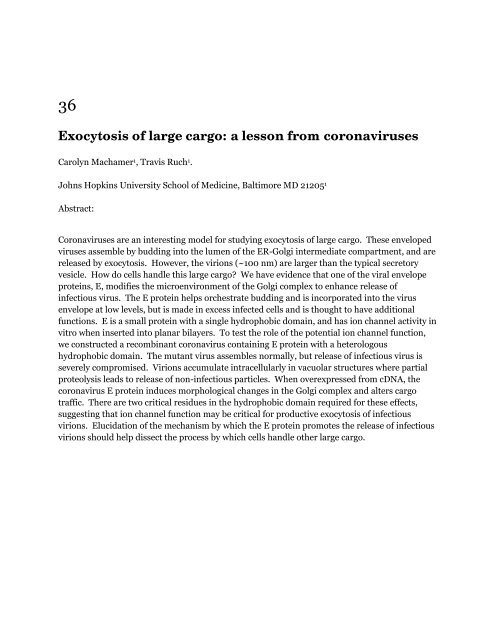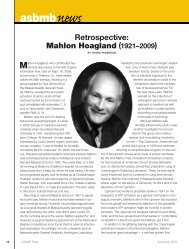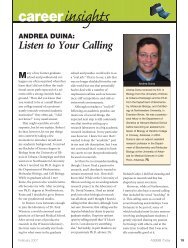View Program - asbmb
View Program - asbmb
View Program - asbmb
- TAGS
- program
- asbmb
- www.asbmb.org
Create successful ePaper yourself
Turn your PDF publications into a flip-book with our unique Google optimized e-Paper software.
36<br />
Exocytosis of large cargo: a lesson from coronaviruses<br />
Carolyn Machamer 1 , Travis Ruch 1 .<br />
Johns Hopkins University School of Medicine, Baltimore MD 21205 1<br />
Abstract:<br />
Coronaviruses are an interesting model for studying exocytosis of large cargo. These enveloped<br />
viruses assemble by budding into the lumen of the ER-Golgi intermediate compartment, and are<br />
released by exocytosis. However, the virions (~100 nm) are larger than the typical secretory<br />
vesicle. How do cells handle this large cargo? We have evidence that one of the viral envelope<br />
proteins, E, modifies the microenvironment of the Golgi complex to enhance release of<br />
infectious virus. The E protein helps orchestrate budding and is incorporated into the virus<br />
envelope at low levels, but is made in excess infected cells and is thought to have additional<br />
functions. E is a small protein with a single hydrophobic domain, and has ion channel activity in<br />
vitro when inserted into planar bilayers. To test the role of the potential ion channel function,<br />
we constructed a recombinant coronavirus containing E protein with a heterologous<br />
hydrophobic domain. The mutant virus assembles normally, but release of infectious virus is<br />
severely compromised. Virions accumulate intracellularly in vacuolar structures where partial<br />
proteolysis leads to release of non-infectious particles. When overexpressed from cDNA, the<br />
coronavirus E protein induces morphological changes in the Golgi complex and alters cargo<br />
traffic. There are two critical residues in the hydrophobic domain required for these effects,<br />
suggesting that ion channel function may be critical for productive exocytosis of infectious<br />
virions. Elucidation of the mechanism by which the E protein promotes the release of infectious<br />
virions should help dissect the process by which cells handle other large cargo.






